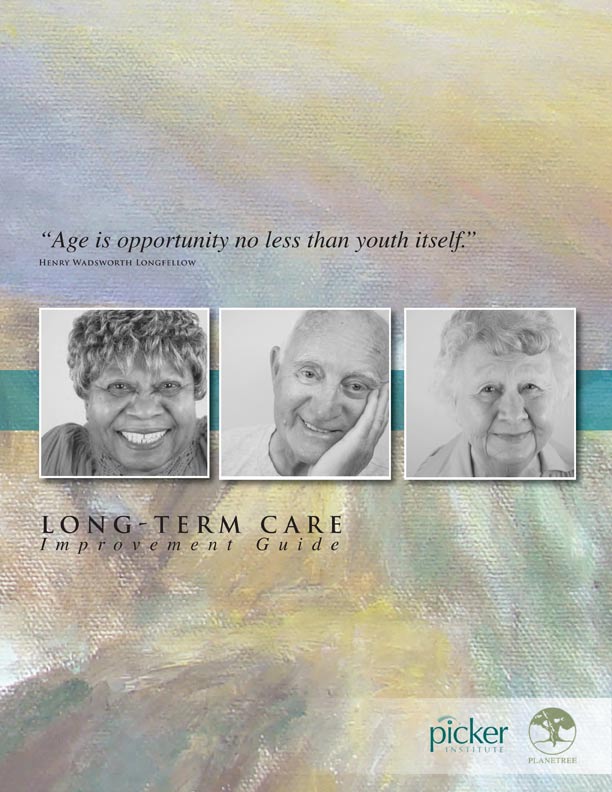“The Long-Term Care Improvement Guide,” published by Planetree in partnership with Picker Institute, is a first-of-its-kind compendium of innovations and approaches created with the aim of propelling organizations in their culture change efforts.
Grounded in the voice of residents, leaders, and frontline staff and spanning all models and settings, this unique resource complements and adds fresh insights and information to the existing body of literature about culture change.
By spotlighting practices and tools from the field that have proven to be effective in meeting the full range of resident and staff needs and preferences, the guide aims to encourage communities to take action and serves as a road map for the process of engaging all stakeholders in a sustainable culture change journey.

The aim was to develop content driven by the resident, family, and staff voices within—and across—the full spectrum of settings that comprise long term care.
Commonalities that emerged during the focus group analysis and leadership dialogues provided the opportunity to examine person-centered practices that will likely work well across the continuum of care, with special attention placed on the nuances of different settings and how such practices can be adapted to meet the needs of specific populations.
What The Guide Offers
The
online version of the guide contains a chapter-by-chapter feature that allows users to pinpoint specific information. The entire guide may also be downloaded in its entirety as a PDF document.
Users can also access a variety of practical tools such as sample policies, job descriptions, and evaluation methods utilized by long term care providers that are effectively implementing culture change. At the beginning of the guide is a Self-Assessment Tool, developed to support users by helping them to navigate to content that is most pertinent to the user’s organization. Completion of the tool is a good starting point for identifying and prioritizing opportunities for improvement and enhancement.
The findings can be used to inform a site-specific implementation plan and to guide the trajectory of the change effort. Involving all stakeholder groups in completing the tool, and broadly sharing the findings, positions the company for any subsequent actions for greater success by establishing the change efforts as community-driven.
For communities in the early stages of the change process, creating a sense of urgency for why business as usual will no longer suffice is essential. Section One, Making the Case for Change, uses outcomes data to demonstrate that improving the long term care experience for those who live and work in these communities is not merely a moral imperative, but increasingly a financial one. The data presented may be useful in creating a platform from which to launch improvement efforts. This section also tackles 20 of the most persistent myths that have long curtailed change efforts and demonstrates why they need not stand in the way of improvement.

Section Two, Building Community, explores a defined process for engaging all stakeholders in creating, implementing, and anchoring a comprehensive vision for change. Consistent with the aim of the guide to transcend specific models, the change process defined here is not specific to any one philosophy.
The description of the change process is complemented with specific tools providers have used related to the different steps.
Section Three, Practical Approaches for Building a Resident-Centered Culture, is organized around aspects of life in long term care communities identified as priorities by residents and staff. Topics covered include systems for getting to know residents, approaches to resident-centered staffing, the move-in process, grief and loss, spirituality, managing risk, culinary engagement, experiences that promote well-being, and transitions of care. This section presents resident-centered practices in place within a diverse set of culturally transforming long term care communities. Many of the strategies featured are relatively simple changes that can be implemented quickly and at little cost to the organization. The sequencing of the sections within the guide, though, is very intentional.
The intended audience for the guide is not limited to those organizations yet to embark on a journey of transformation. It is equally relevant to those long guided by a person-centered philosophy who may be feeling stalled or who may be exploring what more can be done to cement and strengthen an already established culture.
Care Transitions
In the Transitions of Care section, long term care leaders imparted their experiences with implementing, measuring, and sustaining resident-centered care. They also shared their insights into how culture change principles take on even greater relevance in this changing health care landscape, where person-centeredness and care coordination are emphasized as fundamental components of provider strategies to improve safety, quality of care, and health outcomes while at the same time avoiding significant costs and reducing inappropriate readmissions.
With the move toward bundled payments, the quality-of-care transitions will soon have profound repercussions not only on individual patient and resident experience but also on providers’ bottom lines.
Work to apply person-centered concepts to the transitions of care, therefore, is an important extension of any long term care community’s work to become more resident-directed and relationship-centered. Evidence has demonstrated definitively that quality transitions of care depend upon resident engagement, effective communication, family involvement, and care coordination.
The project partners hospitals with local nursing facilities to improve care transitions through implementation of a validated Web-based patient self-assessment tool and a coordinated, cross-setting care partner program.
Heidi Gil is senior director of continuing care at Plantree, Derby, Conn. She can be reached at (203) 732-1365 or hgil@planetree.org.